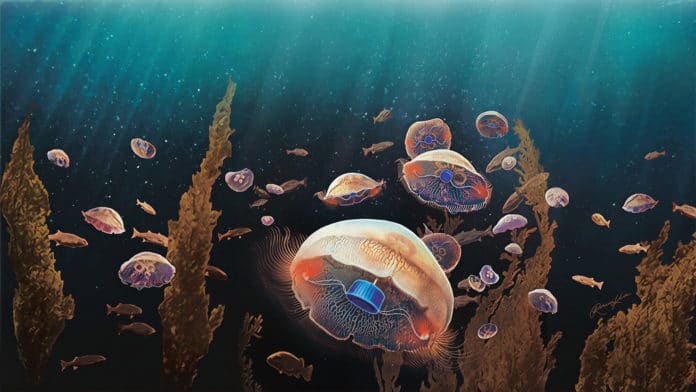Despite all the efforts of scientists to explore the ocean, the vast majority of its depths remain invisible. A number of expensive tools such as depth-defying submarines and swimming drones are expected to cover even a fraction of this water. But they are not able to alleviate this lack of information, so researchers from the California Institute of Technology and Stanford University have explored a possible future solution.
The team has developed a small bionic prosthesis that allows jellyfish to swim faster and more efficiently. The ultimate goal is to use these animals to explore and record information about the oceans.
The microelectronic “prosthesis” or “swim controller” is approximately two centimeters in diameter that emits fine electrical impulses. It is attached via a small wooden barb under the umbrella of the animals.
When active, the prosthesis stimulates the jellyfish muscles with a regular electronic pulse. This regulates and accelerates the movement of the jellyfish. Similar to how a cardiac pacemaker regulates heart rate, this device can influence the pulsation of the jellyfish umbrella, the scientists explain.
The scientists, who report their study in the scientific journal ‘Science Advances‘, tested the device on six lunar jellyfish in a tank and discovered that it could swim the animals almost three times faster than its natural rhythm, without stress. With the device turned off, they went back to swimming normally.
Also, the jellyfish were closely monitored to make sure that they were not harmed. The researchers explain that jellyfish neither have a brain nor have pain receptors. But, it has been shown that they can react to impairments with increased secretion of mucus. However, the researchers’ investigations showed that this was not the case in their experiments. They could also easily remove the pacemakers from the jellyfish. Researchers claimed that the concept did not cause any damage to the experimental animals.
Compared to fully artificial underwater robots, the prosthetic-equipped jellyfish are over 1,000 times more efficient. Only a small amount of current is required for the eight electrodes that stimulate the muscles of the nerves. Also, they find their own fuel and can travel into deep submarine trenches.
So far, the system has only been able to control the speed of the jellyfish. But the scientists are already working on equipment that can be steered in certain directions and react to signals. These types of energy-efficient bio hybrids could be used to explore the depths of the ocean, writes American researchers.
But before it becomes relevant to send jellyfish robots on a larger scale, researchers must learn to control jellyfish, they add. This should be done by activating the eight electrodes in specific patterns – which remain to be explored.
